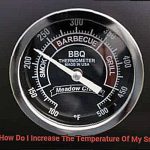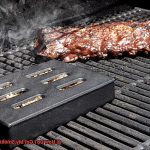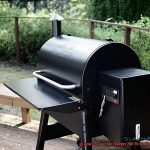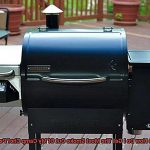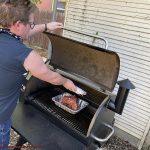Smoking, oh man, it’s like magic for your taste buds. That slow-cooked, smoky goodness can turn even the toughest cuts of meat into melt-in-your-mouth masterpieces. But let’s be real here – getting your smoker to behave and stay at the right temperature is a whole different ballgame.
We’ve all been there, staring at our smokers like they’re some kind of rebellious teenager who just won’t listen. You want that perfect balance of heat and smoke, but your smoker has other plans. It’s either too hot, too cold, or just plain unpredictable.
Well, my friend, you’ve come to the right place. In this blog post, we’re diving deep into the art of temperature control. We’ll give you the lowdown on all the tricks and techniques you need to keep that smoker in check and deliver those mouthwatering results every single time.
Whether you’re a seasoned pitmaster or a backyard BBQ warrior looking to up your game, we’ve got your back. Get ready to impress your buddies with juicy, tender meats that’ll have them begging for more. Let’s get smoking.
Contents
Factors to Consider for Temperature Control
Grilling enthusiasts understand that smoking is an art that goes beyond quality meat or secret sauces. It’s about achieving tender, smoky flavors that make taste buds dance. And the secret ingredient? Temperature control. In this article, we’ll dive into the factors you need to consider to become a true temperature control master in your smoker, ensuring perfectly grilled delights every time.
Type of Smoker:
To conquer temperature control, you must first understand your smoker’s mechanisms. Charcoal smokers demand more attention and adjustment, while electric and gas smokers offer built-in temperature controls for effortless regulation. Choose the type that aligns with your skill level and desired level of control.
Airflow
Prepare to be captivated as we delve into the intricate details of how airflow influences temperature control in your smoker.
Let’s start by exploring the design of your smoker. Whether you’re rocking an offset, vertical, or bullet smoker, each has its own unique airflow mechanism. Understanding the nuances of your specific smoker will empower you to make precise adjustments and unlock the full potential of your culinary creations.
Now, picture this: your vents are the gatekeepers of airflow, allowing oxygen to flow freely or putting a gentle constraint on its path. Proper ventilation is key to maintaining a consistent temperature. Picture yourself adjusting those vents like a maestro conducting a symphony, opening them up to invite in more oxygen and closing them partially to reduce airflow and lower the temperature. Finding that sweet spot is an art form that separates the masters from the novices.
But wait, there’s more. Positioning is everything in the world of airflow. Imagine your smoker as a majestic tower, with an intake vent at the bottom and an exhaust vent at the top. This strategic setup ensures a natural flow of air from bottom to top, channeling heat throughout every nook and cranny of your smoking chamber. It’s like a symphony of flavors being orchestrated by Mother Nature herself.
Now, let’s talk about one secret weapon – the mighty chimney starter. This ingenious device ignites your charcoal evenly, ensuring a uniform distribution of heat-generating embers. With this tool in hand, you bid farewell to unevenly distributed coals causing pesky airflow disruptions. Say hello to effortless control over your smoking environment.
But beware, my friend, for external factors can throw off this delicate balance. Wind gusts can disrupt the natural flow of air, so seek sheltered spots for your smoker whenever possible. And extreme temperatures? They can play tricks on your smoker’s heat retention, demanding adjustments to maintain that perfect equilibrium of flavors.
Fuel Type
When it comes to choosing the right fuel type for your smoker, there are several options to consider. Each fuel type has its own advantages and disadvantages, so let’s explore them in more detail.
- Charcoal: The classic choice for smokers, charcoal provides a distinct smoky flavor that is hard to beat. It can reach high temperatures, making it perfect for slow cooking and smoking. However, charcoal requires proper ventilation and attention to maintain a consistent temperature. If you’re up for the challenge and crave that authentic smoky flavor, charcoal is the way to go.
- Wood Pellets: Wood pellet smokers offer convenience and precise temperature control. Made from compressed sawdust, wood pellets come in various flavors like hickory, mesquite, or applewood, allowing you to experiment with different tastes. They deliver that mouthwatering smoky flavor we all love. Wood pellet smokers are a great option for those who want convenience without compromising on flavor.
- Propane: If ultimate convenience is what you’re after, propane smokers are a fantastic choice. Propane is readily available and offers quick heating, making it ideal for busy individuals. However, propane smokers may lack the intense smoky flavor that charcoal or wood pellet smokers provide. If you prioritize convenience over flavor intensity, propane is your go-to fuel type.
- Electric: For ease of use, electric smokers are the way to go. These modern marvels eliminate the need for dealing with fuel sources and provide consistent temperature control with just a push of a button. Electric smokers are perfect for apartment dwellers or those living in areas with restrictions on open flames. Plug it in, set the temperature, and let the smoker do all the work.
- Hybrid: If versatility is what you’re looking for, hybrid smokers are the answer. These smokers combine different fuel types such as charcoal, gas, or electric elements, giving you the flexibility to switch between fuel sources depending on your preferences or cooking needs. Hybrid smokers are perfect for the adventurous grill master who wants to experiment with different flavors and techniques.
Fuel Placement
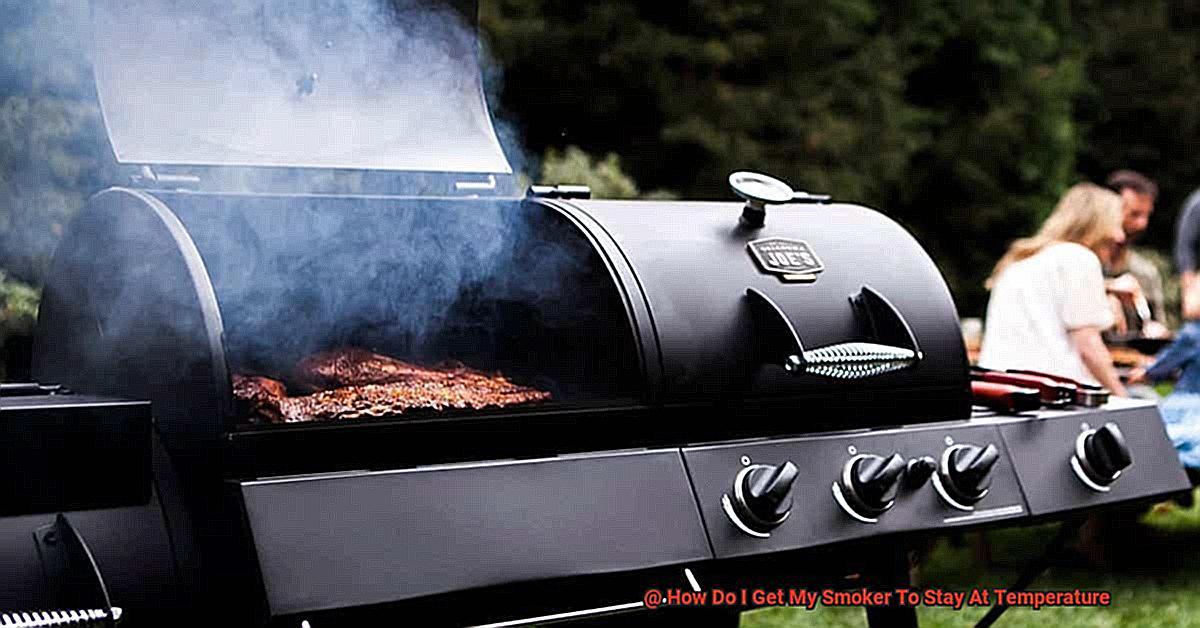
What many may not realize is that fuel placement plays a crucial role in this process. In this section, we will delve into the world of fuel placement and explore why it is essential for achieving grilling greatness.
Choose the Right Fuel:
To begin our exploration of fuel placement, it is important to select the appropriate type of fuel for your smoker. Popular options include charcoal, wood chips, and wood chunks. Each fuel type has its own unique characteristics and burn rates, so choose the one that best suits your taste and cooking style.
Building the Fire Bed:
Creating a well-structured fire bed is essential for maintaining a steady temperature throughout the cooking process. Start by laying a foundation of unlit charcoal or wood chunks at the bottom of your smoker. This foundation ensures consistent heat distribution and temperature control.
Achieving Even Distribution:
Once you have established your unlit fuel bed, it’s time to add lit charcoal or wood chips on top. By evenly distributing these lit fuels across the unlit bed, you will achieve consistent heating throughout the smoker. This even distribution ignites the fire, generating both smoke and heat.
Temperature Control through Placement:
Regulating temperature in your smoker can be achieved by strategically placing your fuel in different areas. If you desire more heat in specific parts of the smoker, place more fuel directly underneath those areas. Conversely, if you need to lower the temperature, shift the fuel away or reduce the number of lit coals.
Airflow is Key:
Proper airflow within the smoker is crucial for maintaining a steady temperature and preventing hot spots or uneven cooking. Allow sufficient space between fuel pieces to facilitate air circulation. Additionally, some smokers have adjustable vents or dampers that control airflow. Experiment with different vent positions to find the perfect balance for your desired temperature.
Monitor and Maintain:
Throughout the cooking process, vigilantly monitor your fuel and make adjustments as necessary. As the fuel burns, you may need to add more charcoal or wood chips to sustain the fire and maintain the desired temperature. This attentiveness guarantees a consistent heat source and ultimately delivers perfectly grilled results.
Temperature Monitoring
Temperature monitoring is an essential component of achieving grilling perfection. Whether you’re a seasoned grill master or just starting out, keeping a close eye on the temperature of your smoker is the secret ingredient to mouthwatering smoked meats and delicious dishes. In this guide, we will explore the importance of temperature monitoring, the tools you need, and the strategies to ensure consistent heat levels throughout the smoking process.
First and foremost, it’s crucial to understand that different types of smokers have varying temperature control mechanisms. Whether you’re using a charcoal, electric, or pellet smoker, take the time to familiarize yourself with its features and functions. Knowing how your specific smoker operates will allow you to effectively monitor and regulate the temperature.
Now let’s talk about the star of the show – the thermometer. This trusty tool comes in various forms, from classic dial thermometers to sleek digital and wireless options. When choosing a thermometer, accuracy and a wide temperature range suitable for smoking should be your top priorities. Investing in a high-quality thermometer will ensure that you get precise readings every time.
Proper thermometer placement is key to accurate temperature monitoring. Position the thermometer near your food to measure the air temperature accurately. Avoid placing it directly above the heat source as this can result in skewed readings. Additionally, regularly calibrating your thermometer will guarantee precise measurements.
Once you have your thermometer in place, it’s time to start monitoring that temperature like a boss. Fluctuations in heat can occur due to factors such as weather changes, opening and closing the smoker lid, or adding fuel. By keeping a close eye on the temperature throughout the smoking process, you can make necessary adjustments to maintain a steady heat level.
Understanding temperature zones within your smoker is another critical aspect of temperature monitoring. Different areas may have varying temperatures due to heat distribution and airflow patterns. By identifying these zones, you can strategically position your food for even cooking and prevent any hot or cold spots.
Adjusting the Vents for Proper Airflow
Today, we’re delving into the art of adjusting vents on your smoker to achieve optimal airflow and consistent temperature. Consider this your backstage pass to becoming a maestro of smoke and fire.
Know Your Smoker:
Just as a dance partner understands your every move, get familiar with your smoker’s unique quirks. Whether it’s charcoal, electric, or pellet, embrace its personality to wield control over the flames.
The Thermometer: Your Trusted Sidekick:
Choose a reliable thermometer that can handle high temperatures and provides accurate readings. Place it strategically near your food to capture the true essence of air temperature without being fooled by the scorching heat source.
Opening Act: Preheating with Open Vents:
Before showtime, open all vents fully to allow maximum airflow during preheating. This helps establish an initial temperature benchmark.
The Top Vent Wide, Bottom Vent Low Technique:
During the performance, leave the top vent fully or partially open to let smoke and heat escape easily. This creates a smoother flow of air. Adjust the bottom vent to control the amount of oxygen entering the smoker.
Fine-Tuning for Temperature Control:
If things get too hot, slightly close the bottom vent to restrict airflow and reduce combustion intensity. For lower temperatures, open the bottom vent wider to increase airflow and fuel combustion.
Small Adjustments with Patience:
Remember, Rome wasn’t built in a day, and neither is perfect barbecue. Make gradual adjustments to avoid drastic temperature changes. Vent adjustments take time to take effect, so exercise patience.
Monitoring and Experimentation:
Equip yourself with a reliable thermometer and keep an eye on both the cooking chamber and meat probe temperatures. Use these readings to make informed decisions about vent adjustments. Factors like ambient temperature, wind conditions, and fuel type can also influence vent settings, so experiment and learn through experience.
Conclusion:
By adjusting the vents for proper airflow, you become the conductor of heat within your smoker, creating symphonies of flavor and tenderness. With knowledge, precision tools, and a watchful eye, you’re now ready to embark on your grilling masterpiece journey. So fire up those smokers, adjust those vents, and get ready to dazzle with your perfectly smoked creations.
Research:
- The vents on a smoker play a crucial role in maintaining a consistent temperature throughout the cooking process. By adjusting the vents properly, you can control the amount of oxygen flowing into the smoker, which directly affects the combustion of fuel and airflow.
- Different smokers have different vent configurations, but the principles for adjusting them remain the same.
- To start, open all the vents fully when preheating the smoker. This allows for maximum airflow and helps establish an initial temperature.
Selecting the Right Type of Fuel
Embark on a mouthwatering flavor-filled journey with your smoker by selecting the right fuel. In this comprehensive guide, we’ll explore the various fuel options available and discuss the key factors to consider when making your decision.
Charcoal:
For smoking enthusiasts, charcoal is a timeless choice. It provides a consistent heat source and comes in two forms: briquettes and lump charcoal. Briquettes offer uniformity and easy temperature control, while lump charcoal, crafted from natural hardwood, burns hotter and faster, demanding more attention. Consider the flavors you wish to infuse into your food when choosing between these two options.
Wood Pellets:
Wood pellets have gained popularity due to their convenience and versatility. Made from compressed sawdust, they come in an array of flavors like hickory, mesquite, and applewood. Pellet smokers employ an automated system that ensures consistent temperature control. However, keep in mind that you may need additional equipment for this type of fuel.
Propane:
If convenience is your priority, propane smokers are worth considering. They offer quick and easy heat with precise temperature control through adjustable valves and knobs. While propane can be more expensive compared to other options, it provides simplicity and hassle-free smoking.
Factors to Consider:
- Flavor Profile: Different fuel types impart distinct flavors to your food. Mesquite wood delivers a bold smoky taste, while fruitwoods like apple or cherry offer a sweeter aroma. Consider the flavor profile you desire when selecting your fuel.
- Availability and Cost: Think about the accessibility and affordability of the fuel you choose. Charcoal and wood pellets are generally more readily available, while propane can be found in most hardware or outdoor stores.
- Ease of Use and Maintenance: Some smokers require more attention and monitoring to maintain a consistent temperature, while others offer automated systems for convenience. Consider your level of expertise and the amount of time you’re willing to invest in maintaining your smoker.
Placing Fuel for Consistent Heat
Today, we embark on a journey into the intricate world of placing fuel in your smoker to maintain a consistent heat throughout your cooking process. Prepare for a game-changing experience that will elevate your smoking prowess.
Let us begin by exploring the various techniques that can help you achieve the perfect temperature balance. First on our list is the two-zone fire technique. This method involves skillfully placing your fuel on one side of the smoker while leaving the other side empty. By doing so, you create a harmonious blend of direct and indirect heat, granting you full control over the temperature – it’s akin to having your own personal thermostat.
Our next technique, known as the minion method (no, not like those adorable yellow creatures), is a firm favorite among smoking aficionados. Here’s how it works: carefully position a small amount of lit charcoal atop a larger pile of unlit charcoal. This slow burn will keep your smoker at a consistent temperature for extended periods – ideal for those low and slow cooks that produce mouthwatering results.
Now, let’s delve into the realm of adding an extra flavor punch with wood chips or chunks. When utilizing these aromatic delights, be sure to place them atop the lit charcoal. This strategic placement allows them to smolder and gracefully release their tantalizing smoke. Brace yourself for an explosion of taste that will leave your palate begging for more.
As you embark on your smoking masterpiece, it is imperative to remain vigilant regarding fuel levels. Adding too much fuel will cause an unwelcome spike in temperature, while too little will result in a disappointing drop in heat. Remember, consistency is the key ingredient in this culinary symphony.
Do not shy away from experimentation on your journey to becoming a smoking maestro. Try different types of fuel – be it charcoal briquettes or hardwood lump charcoal – and discover which one resonates with your taste buds. Finding your perfect match in the grilling world is akin to finding true love.
Let us not overlook the importance of vents and dampers in this delicate dance of temperature regulation. These modest yet crucial components function as the guardians of your smoker’s heat. Widening the vents increases airflow, raising the temperature, while partially closing them restricts airflow, lowering the temperature. Picture yourself as the conductor of a smoking symphony, with the vents and dampers as your trusted orchestra.
Lastly, keep a watchful eye on your smoker’s thermometer. Fine-tuning may be necessary throughout the cooking process – adding or reducing fuel, adjusting vents, or even employing a water pan to maintain control over the heat. Embrace your role as the maestro of this smoking symphony.
Monitoring the Temperature with a Thermometer
Attention, grill masters. If you want to take your barbecuing game to the next level, monitoring the temperature with a thermometer is an absolute must. It’s the secret ingredient that guarantees perfectly cooked meat every single time. Let’s dive into why using a thermometer is so important when grilling or smoking meat.
- Accurate Temperature Control: A thermometer is your ticket to maintaining a consistent heat level inside your smoker. This is crucial for achieving juicy, tender meat that melts in your mouth. With real-time temperature readings at your fingertips, you can make any necessary adjustments to ensure your smoker stays at the desired temperature throughout the entire cooking process.
- Types of Thermometers: There are various types of thermometers available for monitoring smoker temperatures. The probe thermometer, equipped with a metal probe and digital display unit, is a popular choice. It provides incredibly accurate readings and allows you to monitor the progress of your smoking session. Another option is the dial thermometer, mounted on the smoker or lid, which offers easy-to-read temperature indications.
- Proper Probe Placement: To get an accurate reading of the internal temperature of your meat, it’s essential to place the probe in the right location. Aim for the thickest part of the meat without touching any bones or fat. This ensures that you know exactly when your meat is fully cooked and ready to be devoured.
- Monitoring Overall Smoker Temperature: Placing a separate probe or thermometer near the cooking grate gives you an idea of how hot your smoker is overall. This helps you adjust vents or add more fuel if needed to maintain a steady heat. Remember, different areas of the smoker may have slightly different temperatures, so multiple probes in different locations will provide more accurate readings.
- Troubleshooting Made Easy: If you encounter temperature fluctuations or struggle to reach your desired heat level, a thermometer comes to the rescue. It provides insight into what’s happening inside your smoker, allowing you to troubleshoot issues and make the necessary adjustments. With a thermometer by your side, you can keep your cooking on track and create mouthwatering masterpieces every time you fire up that smoker.
Using a Water Pan or Drip Pan for Regulation
When it comes to smoking meat, maintaining a consistent temperature is crucial for achieving that perfect, mouthwatering result. This is where using a water pan or drip pan can be a game-changer. These handy tools help regulate the temperature in your smoker, ensuring that your meat cooks evenly and stays juicy throughout the process.
Let’s start by discussing the benefits of using a water pan. A water pan is typically placed directly above the heat source in your smoker. It serves two main purposes: creating a moist environment and acting as a temperature buffer.
The moisture from the water pan helps prevent your meat from drying out during the long cooking process. As the water evaporates, it absorbs heat, which prevents sudden fluctuations in the smoker’s internal temperature. This stability is essential for achieving consistent results and avoiding overcooked or undercooked meat.
Furthermore, the steam created by the water pan adds flavor to your meat. As it evaporates, it infuses the meat with moisture, resulting in a tender and succulent end product.
Now, let’s move on to the benefits of using a drip pan. A drip pan is positioned below the cooking grates to catch any drippings or grease that may fall from your meat. Not only does this make clean-up easier, but it also helps regulate the temperature in your smoker.
When fats and juices drip onto the hot coals or heating element, they can cause flare-ups and temperature spikes. By using a drip pan, you prevent these flare-ups from happening, maintaining a more consistent heat level.
Additionally, a drip pan can be useful for indirect cooking methods. If you’re smoking larger cuts of meat or using a multi-zone setup, you can place the meat over the drip pan to catch any drippings. This prevents flare-ups while still infusing the meat with flavor.
It’s important to note that not all smokers require a water pan or drip pan. Some smokers may have built-in water pans or drip pans as part of their design. However, for smokers that don’t have these features, using separate water pans or drip pans can significantly improve the quality of your barbecue.
Avoid Opening and Closing the Smoker Lid Frequently
You’ve just invested in a shiny new smoker, and you’re ready to take your grilling game to the next level. That’s awesome. But before you dive headfirst into the smoking world, there’s one crucial thing you need to know: avoid opening and closing the smoker lid frequently. Trust me; it can make or break your grilling experience. Let’s dig in and find out why.
- Temperature control is key: When you open that lid, heat and smoke escape faster than a bullet train. And guess what? It messes up the temperature inside your smoker. Consistency is vital when it comes to smoking meat to perfection, and frequent lid openings can throw it off balance. So resist the temptation to constantly check on your food and trust in the magic happening inside.
- Use your meat thermometer like a pro: Instead of peeping inside every few minutes, invest in a reliable meat thermometer. This little gadget will be your best friend throughout your grilling journey. It allows you to monitor the internal temperature of your food without disrupting the cooking process. Plus, it takes away all the guesswork, ensuring that your meat is perfectly cooked every time.
- Plan ahead and fuel up wisely: One common reason for opening the lid is to add more wood chips or charcoal. While this may be necessary at times, it’s best to plan ahead and add enough fuel at the beginning of the cooking process. This way, you won’t have to open the lid frequently for refueling, minimizing heat loss and maintaining that steady temperature.
- Be quick and efficient: If you do need to add more fuel or make adjustments, be lightning-fast. Have everything you need within arm’s reach before opening that lid – extra wood chips, utensils, you name it. The longer the lid is open, the more heat and smoke escape, leading to significant temperature drops. So, be prepared and keep that lid closed as much as possible.
- Prep like a pro: Lastly, take some time to prep your ingredients before firing up the smoker. Have everything sliced, diced, and ready to go. By doing so, you can minimize the need to open the lid for preparation tasks, allowing you to focus on maintaining that perfect temperature inside your smoker.
BffydV3CRkg” >
Conclusion
Getting your smoker to stay at the right temperature is crucial for achieving that perfect smoky flavor in your food. But it can be a challenge, especially if you’re new to smoking. However, with a few tips and tricks, you can master the art of temperature control and become a smoking pro.
First and foremost, it’s important to choose the right smoker for your needs. Different smokers have different heat retention capabilities, so understanding your equipment is key. Whether you opt for a charcoal smoker, electric smoker, or pellet smoker, make sure you familiarize yourself with its specific features and functionalities.
Next, proper airflow is essential for maintaining a consistent temperature. Ensure that your smoker has sufficient ventilation by adjusting the dampers or vents accordingly. By regulating the airflow, you can control the amount of oxygen that reaches the fire and ultimately influence the temperature inside.
Another factor to consider is fuel management. Whether you’re using charcoal briquettes, wood chips, or pellets as your heat source, it’s important to monitor and replenish them as needed. Keep an eye on the fuel levels and adjust accordingly to maintain a steady heat output.
Additionally, insulation plays a crucial role in temperature stability. Check for any gaps or leaks in your smoker’s seals and make necessary repairs or upgrades. This will prevent heat from escaping and help maintain a consistent cooking environment.
Furthermore, using a reliable thermometer is essential for accurate temperature monitoring. Invest in a quality probe thermometer to measure both the internal temperature of your smoker and the doneness of your food. This will ensure precision in your cooking process.
Lastly, practice patience and avoid unnecessary fluctuations in temperature by resisting the temptation to constantly open the lid. Every time you do so, heat escapes and disrupts the equilibrium inside. Instead, trust in your preparation and let your smoker work its magic without interference.
In conclusion, getting your smoker to stay at temperature requires attention to detail and understanding of various factors. By choosing the right smoker, managing airflow and fuel, ensuring proper insulation, using a reliable thermometer, and practicing patience, you can achieve consistent and delicious results every time you fire up your smoker.


